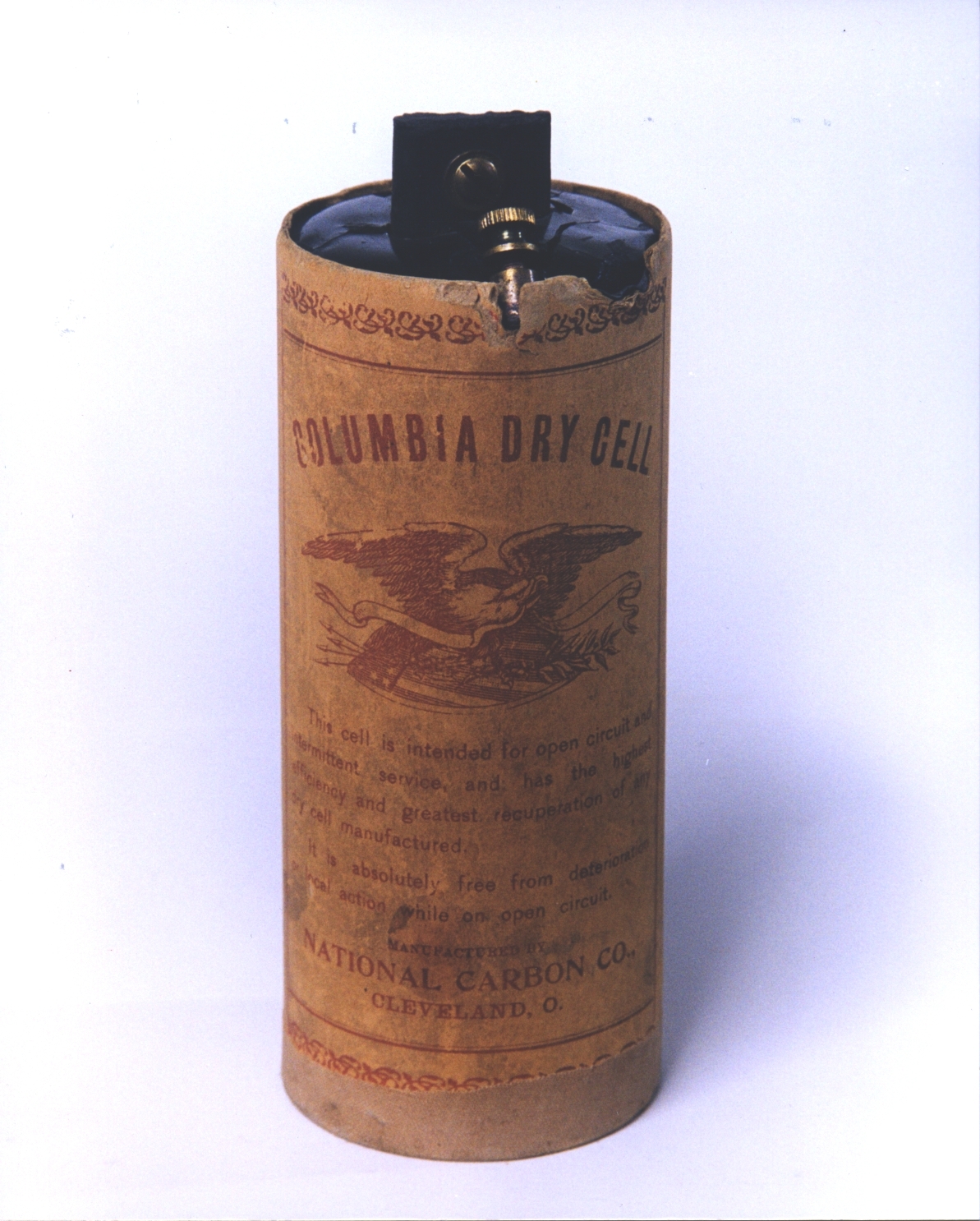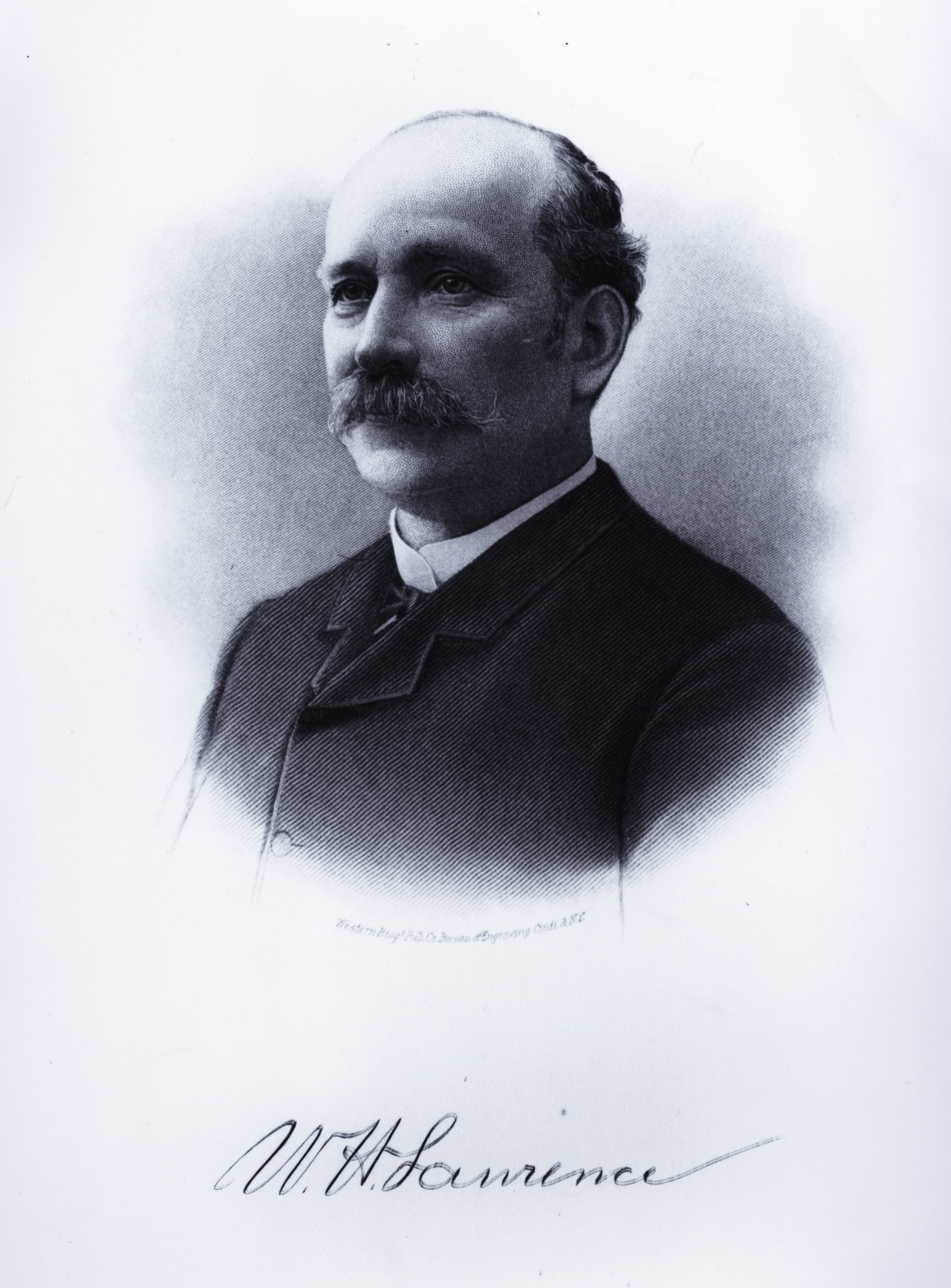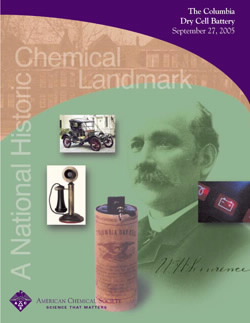The Columbia Dry Cell Battery
Dedicated September 27, 2005, at Energizer Global Technology Center in Cleveland, Ohio, and at Energizer Holdings Inc. headquarters in St. Louis, Missouri.
Imagine a world without batteries. It would be a much different world, in which the automobile and the telephone would have developed differently and probably later. It would also be a world without many of the conveniences and necessities of modern life. The battery, ever smaller and more powerful, defines much of our modern comforts and advances. Many scientific and technological advances were necessary to develop those smaller and more powerful batteries. One of the major leaps in the development of the battery was the introduction of the Columbia Dry Cell in the 1890s by the National Carbon Company, forerunner of Energizer Holdings Inc.
Contents
History of Batteries
Modern battery development can be traced to the work of Luigi Galvani, who observed in the 1780s that a frog’s leg twitched when connected by arcs made of iron and brass. Galvani thought the twitching originated in the leg tissue, suggesting that animals produce electricity (an assertion not definitively proven until the 1840s). Alessandro Volta, another pioneer in the field, thought that Galvani’s explanation was incorrect, and that Galvani’s results arose from his use of two different metals connected by a moist conductor (a frog’s leg).
In the 1790s Volta experimented with inanimate systems consisting of metal plates connected by brine-soaked cardboard to produce an electric current. To build the first modern electrical battery, Volta stacked disks of zinc and silver in pairs to form a “pile.” The “voltaic pile” was the first device that produced a continuous current; this work established the electrochemical principles that remain the basis of batteries used today. For several decades after Volta, all advances in producing electricity still involved the use of liquid electrodes. And well into the 20th century, the medium was always acidic.
The next major advance came in 1866 when Georges Leclanché developed a much-improved battery. Leclanché assembled his cell in a porous pot. The cathode consisted of crushed manganese dioxide with a little carbon added. The anode was a zinc rod. The cathode was packed into the pot with a carbon rod inserted as a current collector. The anode and the pot were then immersed in an ammonium chloride solution, which acted as the electrolyte. The liquid seeped through the porous cup and made contact with the cathode material. Even though it was a heavy, wet cell prone to breaking, Leclanché's invention represented an advance over previous batteries, and it became an immediate success, gaining wide use in telegraph systems within two years of its development.
Further improvements came in the 1880s when Carl Gassner, a German scientist, invented the first dry cell. Gassner used zinc as the container to house the cell’s other components; at the same time, he used the sealed zinc container as the anode. The cathode surrounded a carbon rod. Gassner also added zinc chloride to the electrolyte, which markedly reduced corrosion of the zinc when the cell was idle and added considerably to its shelf life.

"Imagine a world without batteries! A teenager walks outside wearing headphones, tethered to home by a lengthy extension cord. An old man winds his pacemaker like a pocket watch… In thousands of ways, large and small, batteries have changed our daily lives."
— Mary Ellen Bowden, Chemistry is Electric! (Philadelphia, Chemical Heritage Foundation, 1997), p.26.
Production of the Columbia Dry Cell Battery
Battery development shifted in the 1890s to the U.S. with the development of the Columbia Dry Cell by the National Carbon Company (NCC) — the corporate predecessor of Energizer Holdings. NCC was founded in Cleveland, Ohio, in 1886 by Washington H. Lawrence, a pioneer in the manufacture of electrical products.
In 1894, NCC began marketing Leclanché wet cells. At the same time, in the mid-1890s, a bright and talented young man, E. M. Jewett, was working in NCC’s Lakewood plant on the west side of Cleveland, under the direction of George Little. Jewett became interested in dry cells and, in his free time, conducted experiments in the laboratory. He developed a paper-lined, 1.5-volt cylindrical dry cell which he showed to Lawrence, who gave Jewett and Little a green light to begin manufacturing commercial dry cells. The trademark “Columbia” was proposed by Nelson C. Cotabish, a sales manager at NCC. In 1896, the company marketed the very first battery intended for widespread consumer use: the sealed, 6-inch, 1.5-volt Columbia battery. NCC was the first company to successfully manufacture and distribute sealed dry-cell batteries on a large scale.
The introduction of the Columbia marked an important step in the transformation of batteries from industrial products to consumer goods. Leclanché wet cells could not meet market needs for a durable, maintenance-free, non-spill, and non-breakable battery that was also inexpensive. The dry cell did, especially with subsequent improvements. One important advance came when NCC began using cardboard coiled into a tube as the separator between the anode and the cathode. Previous dry-cell iterations, such as the Gassner version, had used plaster of paris, which left only a small space for the cathode. This was an inefficient system, and such batteries were difficult to assemble.
The Columbia used a paste of flour and potato starch to coat the separator before it was placed inside the zinc can. This formulation improved ion diffusion through the separator and adhesion of the separator to the can. Also, with improvements, the Columbia used less carbon than earlier batteries, which resulted in an increase in energy density (the energy per unit volume of the medium). The Columbia had one other attribute that made it different from other contemporary batteries: It was not sensitive to orientation. This proved especially important for the automobile industry, since a device that moved could not rely on a power source that worked only when facing in certain directions.
Continued improvements to the Columbia battery led to better performance. Because it was sealed, there was no spillage, and it did not break as easily as its predecessors. It was also chemically efficient and economical to produce. Accordingly, the 6-inch, 1.5-volt Columbia satisfied the requirements of the consumer market at the beginning of the 20th century. The technology of the Columbia — a carbon-zinc battery using an acidic electrolyte — served as the basis of all dry-cell batteries for the next 60 years, until the introduction of the alkaline battery by the Eveready Battery Company (now Energizer) in the late 1950s.
Battery Power in the Early 20th Century
The late 19th century witnessed many technological advances: The automobile and the telephone were among the most significant. After these key developments, countless electrically powered household appliances were introduced to the market. Demand for these products led to demand for portable, low-maintenance, electrochemical batteries to power them. NCC in Cleveland, Ohio, was ideally situated to meet those demands.
Through the first decade of the 20th century, Cleveland was the nation's automobile center; Detroit was not yet “Motor City.” Cleveland was the leading automobile maker in the world and more Clevelanders owned cars per capita than in any other city. The development of a reliable sealed dry cell was critical to the production of cars. Batteries were used as the “igniter” in early automobiles, much as spark plugs are used in modern internal combustion engines. According to an early patent, “gasolene [sic] or other vapor-operated automobiles employ a sparking device for igniting the vapor at each alternate stroke of the engine-piston. The device in common use consists of a plurality of dry batteries.” However, the emergence of the magneto in 1907 and the invention of the electric starter in 1911, powered by a rechargeable storage battery, eventually made dry cells unnecessary for this purpose.
The telephone also relied on batteries. In 1893 Alexander Graham Bell’s original patents expired, leading to an explosion of telephone manufacturers and providers. The expansion of telephones into more and more homes led to increased demand for batteries, because dry cells powered home phones well into the 20th century.
At the same time, batteries were playing a critical role in the adaptation of electric current to household devices. The mass production of domestic sources of power — batteries — made possible the introduction of electric doorbells, burglar alarms, electric sewing machines, and incandescent lights, including the battery-powered flashlight.


How Batteries Work
All batteries — whether they are early sealed dry cells, alkaline batteries of the mid-20th century, or more contemporary lithium batteries — have the same purpose and share many of the same characteristics. Batteries store chemical energy, which is then converted into electrical energy used to power a device. Indeed, the need for portable power continues to grow in the modern world.
A battery consists of two different electrodes, either metal or metallic compounds. These are connected by an ion-conducting solution known as an electrolyte. Ions are an atom or molecule that has an electric charge, positive or negative. Fundamental to all batteries is that one electrode (the cathode) attracts electrons more strongly than the other (the anode). The difference in the attraction is the voltage of the cell. In most batteries the anode is zinc, and the cathode is manganese dioxide. When the two electrodes are connected by an electrolyte, chemical reactions can occur between the electrodes and the electrolyte. When a wire is externally connected to the two electrodes, the manganese dioxide’s stronger attraction for electrons pulls the electrons from the zinc electrode through the wire to the manganese dioxide electrode. This process produces a flow of current that powers devices.
The processes by which batteries work and the basic construction has not changed in over a hundred years. New research is aimed at producing smaller, longer-lasting batteries that produce more energy to power ever smaller electronic devices: digital cameras, mobile phones and portable computers. One obvious and dramatic change in batteries is size. The Columbia Dry Cell was 6 inches long; modern batteries for hearing aids and watches are smaller than 1/4 inch by 1/8 inch.
Landmark Designation and Acknowledgments
Landmark Designation
The American Chemical Society designated the Columbia Dry Cell battery as a National Historic Chemical Landmark in a ceremony on September 27, 2005, at Energizer Global Technology Center in Cleveland, Ohio, and Energizer Holdings Inc. headquarters in St. Louis, Missouri. The text of the plaque commemorating the landmark reads:
In 1896 the National Carbon Company (corporate predecessor of Energizer) developed the six-inch, 1.5 volt Columbia battery, the first sealed dry cell successfully manufactured for the mass market. The Columbia, a carbon-zinc battery with an acidic electrolyte, was a significant improvement over previous batteries, meeting consumer demand for a maintenance-free, durable, no-spill, inexpensive electrochemical power source. Finding immediate use in the rapidly expanding telephone and automobile industries, the Columbia launched the modern battery industry by serving as the basis for all dry cells for the next sixty years.
Acknowledgments
Adapted for the internet from “The Columbia Dry Cell Battery,” produced by the National Historic Chemical Landmarks program of the American Chemical Society in 2005.
Back to National Historic Chemical Landmarks Main Page.
Learn more: About the Landmarks Program.
Take action: Nominate a Landmark and Contact the NHCL Coordinator.



